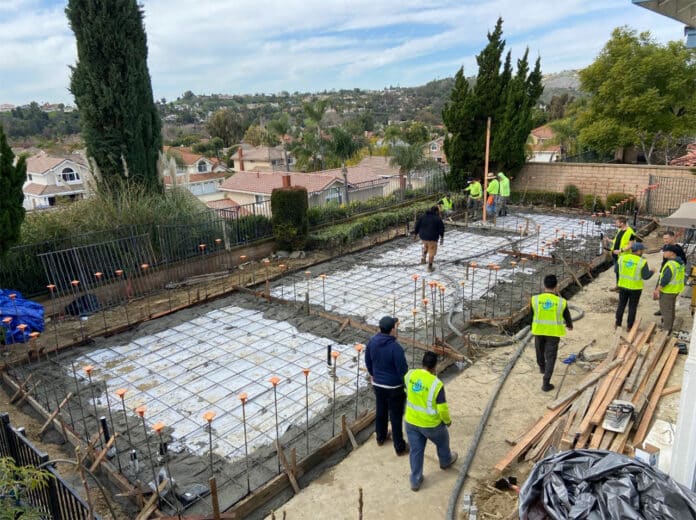The U.S.’s first fire-resistant, 3D-printed concrete accessory dwelling unit (ADU) is under construction in Walnut, California. RIC Technology’s robotic 3D printer will be used to print the ADU’s concrete walls.
The first-of-its-kind project is being led by Builtech Construction Group in collaboration with the City of Walnut and the Los Angeles County Fire Department. K4K Construction Design is the subcontractor responsible for 3D printing.
“Our compact modular robotic 3D printer overcomes conventional gantry systems’ limitations, enabling 3D construction on site, in confined spaces such as people’s backyards,” said Ziyou Xu, founder and CEO of RIC Technology, explaining why this project is a breakthrough in concrete 3D printing’s application to ADU and other affordable housing projects.
Philips and Constance, a couple living in Walnut, are taking steps to contribute to wildfire protection by building a fire-resistant ADU in their backyard. Builtech Construction Group is progressing well with the plumbing and sewage system installation. Once the foundation is laid, RIC Technology’s robotic arm 3D printer will be used to print the house’s exterior walls. The printing process takes only 20 days from the start to finish.
This 1200 sqft ADU will include 2 bedrooms and 2.5 bathrooms. It is non-combustible and fire-resistant, which will provide an added layer of protection.
Xu says this project can be the beginning of something meaningful and can pave the way for wider applications of 3D-printed homes that are more resistant to fires.
Most homes destroyed in wildfires are initially set ablaze by embers and minor flames, and reducing a home’s susceptibility to fire can greatly increase the chances of it surviving a wildfire. According to Wildfire Risk to Communities, a resource hub created by the USDA Forest Service, this fire-resistant home will reduce wildfire risks for homeowners by enhancing resilience during a fire and speeding up post-wildfire recovery.
Xu has stated that this will significantly save time and money in the recovery process if residents’ homes survive a wildfire.
The exterior walls of this ADU will be 3D printed using non-combustible concrete, making it less susceptible to fire. The use of light steel and sure-boards for the roof also sets it apart from other 3D-printed homes that often feature wooden structural roofs.
To further minimize the risk, Builtech will take extra measures to strengthen areas of the home that are traditionally vulnerable to fires, such as eave vents and windows.
“The ADU will be built without a single piece of wood or nail – no ‘fuel’ on the main structure,” said Aaron Liu, CEO of Builtech Construction Group and an NFPA-certified wildfire mitigation specialist (CWMS). “So we significantly minimize the likelihood of fire entering the home, reducing its susceptibility to fire.”
The project was able to receive construction permits in February, even with California’s stringent building codes. The Walnut project could serve as a catalyst for further collaborations with local governments and fire departments in expanding fire-resistant constructions to more communities in California affected by wildfires.
RIC Technology plans to continue its partnership with Builtech Construction Group, focusing on the development of non-combustible, fire-resistant homes for wildfire-prone areas.
